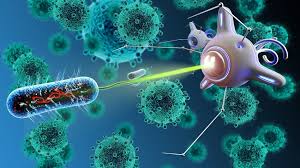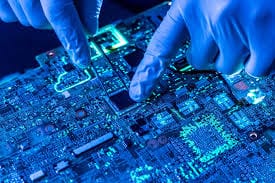Nanotechnology, the science of manipulating matter at the atomic and molecular scale, is one of the most exciting and transformative fields of the 21st century. Operating at the nanoscale—typically between 1 and 100 nanometers—nanotechnology enables scientists and engineers to create materials, devices, and systems with unprecedented precision and functionality. From medicine and electronics to energy and environmental sustainability, nanotechnology is revolutionizing industries and offering solutions to some of humanity’s most pressing challenges. This article explores the origins, applications, challenges, and future potential of nanotechnology.

What is Nanotechnology?
Nanotechnology involves the design, characterization, production, and application of structures, devices, and systems by controlling shape and size at the nanometer scale. To put this into perspective, one nanometer is one-billionth of a meter—about 100,000 times smaller than the width of a human hair. At this scale, materials often exhibit unique physical, chemical, and biological properties that differ significantly from their bulk counterparts. These properties arise due to quantum effects and the increased surface area-to-volume ratio, making nanomaterials highly reactive, conductive, or durable.
The concept of nanotechnology was first introduced by physicist Richard Feynman in his famous 1959 lecture, “There’s Plenty of Room at the Bottom,” where he envisioned the possibility of manipulating individual atoms and molecules. However, it wasn’t until the 1980s, with the invention of the scanning tunneling microscope (STM) and the atomic force microscope (AFM), that scientists gained the tools to observe and manipulate matter at the nanoscale. Since then, nanotechnology has grown into a multidisciplinary field, combining physics, chemistry, biology, engineering, and materials science.
Applications of Nanotechnology

Nanotechnology’s potential spans a wide range of industries, offering innovative solutions to complex problems. Below are some of the most impactful applications:
1. Medicine and Healthcare
Nanotechnology is revolutionizing medicine through advancements in drug delivery, diagnostics, and regenerative medicine.
- Targeted Drug Delivery: Nanoparticles can be engineered to deliver drugs directly to diseased cells, such as cancer cells, minimizing side effects and improving treatment efficacy. For example, liposomes and dendrimers are used to encapsulate drugs and release them at specific sites.
- Diagnostics: Nanosensors and nanodevices enable early detection of diseases by identifying biomarkers at extremely low concentrations. Quantum dots, for instance, are used in imaging to provide highly detailed views of tissues and organs.
- Regenerative Medicine: Nanomaterials like graphene and carbon nanotubes are being used to create scaffolds for tissue engineering, helping to regenerate damaged tissues and organs.
2. Electronics and Computing
The electronics industry has benefited immensely from nanotechnology, leading to smaller, faster, and more efficient devices.
- Semiconductors: Nanoscale transistors and chips have enabled the development of powerful computers and smartphones. For example, Intel and other companies are now producing chips with features as small as 5 nanometers.
- Quantum Computing: Nanotechnology plays a crucial role in the development of quantum computers, which leverage quantum bits (qubits) to perform complex calculations at unprecedented speeds.
- Flexible Electronics: Nanomaterials like graphene and conductive polymers are being used to create flexible, wearable electronics, such as foldable screens and smart clothing.
3. Energy
Nanotechnology is driving innovations in energy production, storage, and conservation.
- Solar Cells: Nanomaterials like perovskite and quantum dots are being used to create highly efficient, low-cost solar panels.
- Batteries: Nanotechnology is improving the performance of batteries by increasing energy density and reducing charging times. For instance, silicon nanowires are being explored as an alternative to traditional graphite anodes in lithium-ion batteries.
- Hydrogen Production: Nanocatalysts are being developed to enhance the efficiency of water-splitting reactions, which produce hydrogen as a clean fuel.
4. Environmental Sustainability
Nanotechnology offers solutions to environmental challenges, including pollution, water purification, and climate change.
- Water Filtration: Nanomaterials like carbon nanotubes and graphene oxide are used in filters to remove contaminants, bacteria, and viruses from water.
- Air Purification: Nanocatalysts can break down harmful pollutants in the air, such as nitrogen oxides and volatile organic compounds.
- Carbon Capture: Nanomaterials are being developed to capture and store carbon dioxide from industrial emissions, helping to mitigate climate change.
5. Manufacturing and Materials
Nanotechnology is transforming manufacturing by enabling the creation of stronger, lighter, and more durable materials.
- Nanocomposites: Materials like carbon nanotubes and nanoclays are being incorporated into polymers to create lightweight, high-strength composites for use in aerospace, automotive, and construction industries.
- Self-Healing Materials: Nanotechnology is being used to develop materials that can repair themselves when damaged, extending their lifespan and reducing waste.
- Coatings: Nanocoatings are being applied to surfaces to make them water-repellent, anti-corrosive, or antimicrobial.
Challenges and Ethical Considerations
Despite its immense potential, nanotechnology also poses significant challenges and ethical concerns that must be addressed.
1. Health and Safety Risks
The unique properties of nanomaterials raise concerns about their potential toxicity and environmental impact. For example, nanoparticles can penetrate biological barriers, such as the blood-brain barrier, and accumulate in organs, leading to unknown health risks. Rigorous testing and regulation are needed to ensure the safe use of nanomaterials.
2. Environmental Impact
The production and disposal of nanomaterials may have unintended consequences for the environment. For instance, nanoparticles released into water systems could harm aquatic life. Sustainable practices and lifecycle assessments are essential to minimize these risks.
3. Ethical and Social Implications
Nanotechnology raises ethical questions about equity, privacy, and security. For example, the use of nanosensors for surveillance could infringe on personal privacy. Additionally, the high cost of nanotechnology research and development may exacerbate global inequalities, as wealthier nations and corporations gain disproportionate access to its benefits.
4. Regulatory Challenges
The rapid pace of nanotechnology innovation often outstrips the development of regulatory frameworks. Governments and international organizations must work together to establish guidelines and standards that ensure the responsible development and use of nanotechnology.
The Future of Nanotechnology
The future of nanotechnology is brimming with possibilities. Here are some emerging trends and potential breakthroughs:
1. Nanomedicine
Advances in nanomedicine could lead to personalized treatments tailored to an individual’s genetic makeup. For example, nanorobots could be used to perform precise surgeries or deliver drugs to specific cells.
2. Smart Materials
The development of smart materials that respond to external stimuli, such as temperature, light, or pressure, could revolutionize industries like construction, textiles, and robotics.
3. Energy Harvesting
Nanotechnology could enable the development of devices that harvest energy from the environment, such as piezoelectric nanomaterials that convert mechanical energy into electricity.
4. Space Exploration
Nanotechnology could play a key role in space exploration by enabling the development of lightweight, durable materials for spacecraft and advanced life-support systems.
5. Artificial Intelligence and Nanotechnology
The integration of nanotechnology with AI could lead to the creation of intelligent nanosystems capable of performing complex tasks, such as monitoring environmental conditions or diagnosing diseases.
Conclusion
Nanotechnology is a powerful tool that has the potential to transform nearly every aspect of our lives. From curing diseases and combating climate change to revolutionizing electronics and manufacturing, its applications are vast and far-reaching. However, as with any transformative technology, it is essential to address the associated challenges and ethical considerations to ensure that its benefits are realized responsibly and equitably.
As we continue to explore the nanoscale world, collaboration between scientists, policymakers, and the public will be crucial in shaping the future of nanotechnology. By harnessing its potential while mitigating its risks, we can unlock a new era of innovation and progress that improves the quality of life for people around the globe. The tiny revolution of nanotechnology is just beginning, and its impact will undoubtedly be felt for generations to come.










